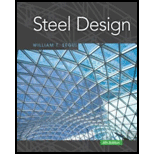
Steel Design (Activate Learning with these NEW titles from Engineering!)
6th Edition
ISBN: 9781337094740
Author: Segui, William T.
Publisher: Cengage Learning
expand_more
expand_more
format_list_bulleted
Question
Chapter 10, Problem 10.6.1P
To determine
(a)
The maximum factored concentrated load that can be supported by using LRFD.
To determine
(b)
The maximum service concentrated load that can be supported by using ASD.
Expert Solution & Answer
Want to see the full answer?
Check out a sample textbook solution
Students have asked these similar questions
The details of an end bearing stiffener are shown in Figure . The stiffener plates are 9⁄16-inch thick, and the web is 3⁄16-inch thick. The stiffeners are clipped 1⁄2 inch to provide clearance for the flange-to-web welds. All steel is A572 Grade 50. a. Use LRFD and determine the maximum factored concentrated load that can be supported. b. Use ASD and determine the maximum service concentrated load that can be supported.
A beam is connected to a column with 3⁄4inchdiameter, Group A slipcritical bolts, as shown in Figure . A992 steel is used for the beam and column, and A36 steel is used for the angles. The force R is the beam reaction. Based on the strength of the 10 angletocolumn bolts, determine: a. The maximum available factored load reaction, Ru, for LRFD. b. The maximum available service load reaction, Ra, for ASD.
Prob 01: An 18” depth beam is bolted to a 24” depth girder is connected similar to that in figure shown below. Thediameter of the rivet is 20mm and the angles are each 100mm x 100mm x 12mm thick. For each bolt, assume thatthe allowable bearing stress is 220 MPa. Determine the allowable load P in KN on the connection. *show all theload P in kN for bearing stressBeam web thickness = 5mmGirder web thickness =
Chapter 10 Solutions
Steel Design (Activate Learning with these NEW titles from Engineering!)
Knowledge Booster
Recommended textbooks for you
 Steel Design (Activate Learning with these NEW ti...Civil EngineeringISBN:9781337094740Author:Segui, William T.Publisher:Cengage Learning
Steel Design (Activate Learning with these NEW ti...Civil EngineeringISBN:9781337094740Author:Segui, William T.Publisher:Cengage Learning

Steel Design (Activate Learning with these NEW ti...
Civil Engineering
ISBN:9781337094740
Author:Segui, William T.
Publisher:Cengage Learning